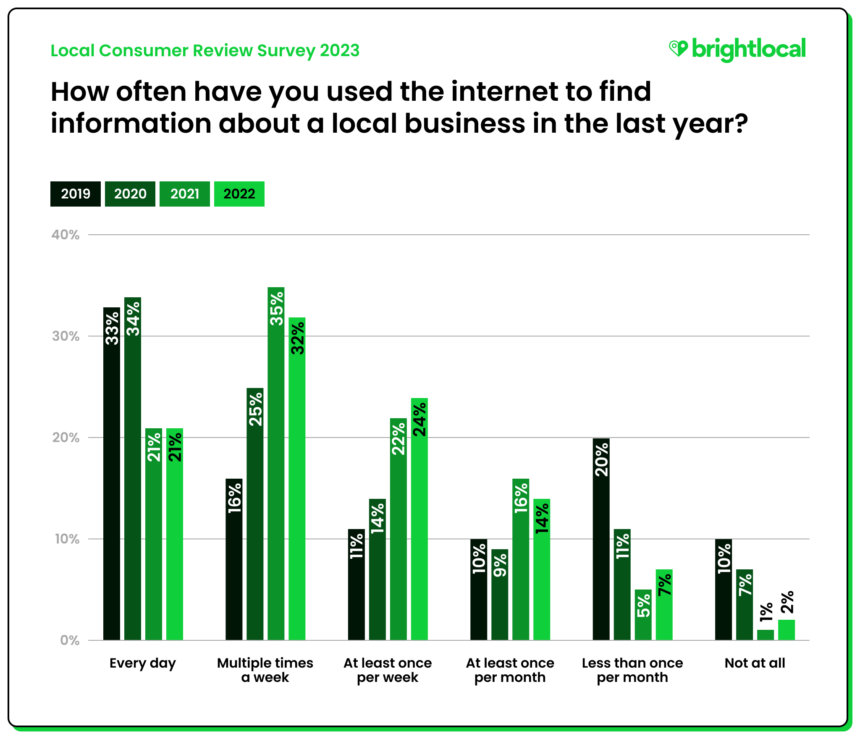How To Create an Effective B2B Website Strategy in 2024
Is your website looking a little outdated? Are customers clicking on your site only to bounce a minute later? If you’ve sadly nodded your head to these questions, it might be time for a new B2B website strategy for 2024.
This kind of project can be daunting, though. With all the exciting new web development trends – MACH architecture, Headless infrastructure, omnichannel marketing– it can be hard to know where to begin.
In this article, we’ll explore absolutely everything you need to know about creating an effective B2B website strategy. Along the way, we’ll touch on what makes a great strategy, the impact of each component in your plan, and move through a step-by-step guide to transforming your website.
Let’s dive right in.
What Is a B2B Web Strategy?
In the B2B world, your website is your primary method of capturing attention. Both buyers and sellers prefer to do business online. And can you blame them? Websites conveniently collect all the necessary information, products, and services that a client is looking for in one place.
Your B2B web strategy is the difference between closing a lead and watching another visitor bounce from your site. A great strategy covers every element, from choosing the right CMS to expanding into omnichannel marketing – and it doesn’t stop there.
A comprehensive B2B web strategy considers both frontend and backend approaches to your business. It encompasses integrations, performance, scalability potential, SEO visibility, and even develops your value proposition.
As businesses become more digital and technology advances, the businesses that remain competitive are the ones that are able to thrive in the online arena. Learning how to plan, develop, and execute a B2B web strategy isn’t just a benefit – it’s a necessity.
That is, if you want to generate more leads, boost conversion, and skyrocket sales. And come on, who doesn’t want that?
How To Develop a B2B Web Strategy
To guide you toward creating a winning B2B web strategy for your business, we’ve broken it down into seven easy steps:
- Planning
- Choosing the right CMS
- Integrating your tools
- Optimising for Mobile
- Omnichannel Marketing
- Scalability
- User Experience
Let’s dive right in.
Have a Detailed Plan of Action
Every great project starts with a solid plan. A B2B website has a range of moving parts, making the planning stage fundamental for success. As the cornerstone for your strategy, this stage will achieve two core objectives:
- Define your goals.
- Identify potential roadblocks
Behind every digital transformation is a set of desires. You may want to redefine your strategy to increase organic traffic or bridge into new marketing channels. Whatever your goals are, this is the stage where you should document them in detail.
Once you’ve identified the targets of your new strategy, it’s time to think about the main problems you might encounter.
Let’s say that you’re currently using outdated website infrastructure. One challenge of your new strategy might be replacing the underlying architecture to ensure it can handle the demands of your new site without losing speed.
Another example could be defining your typical sales pathways. TrustRadius reports that 100% of buyers now prefer having a self-serve option for at least some purchasing processes. If your website relies on sales representatives and face-to-face conversations, then you might have to radically redefine your offerings.
Knowing the main obstacles that lie ahead allows you to put together an effective plan before they ever occur.
With all that covered, we’re ready to head to step two.
Choose the Right CMS for Your Business
A B2B CMS (Content Management System) is the lifeblood of digital businesses.
At a basic level, Your content management system lets you create, modify, and manage all the content on your site without having to touch any code.
But CMSs can do much more than that. Over the years CMSs have evolved to meet the changing demands of modern websites. These systems can provide advanced functionalities that are designed with businesses in mind. This includes more performance and personalisation features, more flexible design and UX capabilities, and the ability to integrate with other systems.
When choosing a B2B CMS, you’ll have to consider things like:
- Its performance and scalability options
- How well it integrates with your other tools
- The level of flexibility it provides
- How straightforward it is for your teams to use
The good news is that you have hundreds of CMS options available with a wide range of features that cover just about every use case imaginable.
The bad news? You have an overwhelming number of options to sift through.
Luckily, most of the major CMS platforms cater to specific business purposes, making it a bit easier to choose the right one for you. Some big names in the industry are:
- Magento: A great customisable e-commerce option.
- Sitecore: Powerful analytics-first CMS platform.
- Contentful: Useful omnichannel CMS experience.
- WordPress: An open-source, customisable, and user-friendly powerhouse.
- Storyblok: Headless architecture done right.
- Drupal: A CMS that focuses on security and customisation above all else.
Several factors will make a CMS stand out to your business. Weighing up the ease of use, range of features, integrations, and flexibility are all important areas to consider.
For a deep-dive on this topic, check out our guide on how to choose an enterprise CMS for your business.
Integrate Essential Tools and Systems
An essential part of building toward your effective B2B website strategy is ensuring that your team’s behind-the-scenes workflow is optimised.
To get the most effective functionality for your team, you’ll need to integrate your other business tools into your CMS. The bigger your business, the more integrations you’ll probably be dealing with. At the very least, you’ll have CRMs and other useful tools to streamline your day-to-day tasks.
Some common integrations include:
- Payment and E-Commerce Options: Stripe, PayPal, Debit and Credit Cards.
- Analytics Software: Google Analytics, Proprietary tools, or a third-party app.
- Customer Relationship Management Platform: Hubspot, Salesforce, Pipedrive.
- Lead Generation: Mailchimp, Unbounce, Hubspot.
Think of backend integrations as ways of making your employees’ lives easier. While setting up all these tools might seem like a hassle in the short term, it’ll pay off for you, your team, and your customers down the line.
Once your backend is looking great, it’s time to move on to the next step.
Optimise Your Site for Mobile Users
We are living in the mobile age. The majority of customers browse and buy from their phones. Chances are, you’re even reading this article on your mobile. Around 60% of all web traffic comes from mobile. That figure reaches even higher in Asia and Africa, which boast 68% and 74% traffic from mobile respectively.
With that in mind, optimising for this growing user segment is vital.

Source: Statista
You can focus on two streams when it comes to mobile optimisation: UX changes and SEO adaptations.
Let’s break each of these down.
UX Changes to Optimise for Mobile
UX changes attempt to ensure a user’s website experience is the same on mobile as on a computer. Without a high degree of mobile usability, phone users might encounter oversized content, formatting issues, or long loading times.
Some areas to focus on with mobile optimisation are:
- Use Responsive Design: Responsive design automatically scales content to adapt to different screen sizes. Enabling this feature on your website will ensure that your content looks the same, no matter what device a user is on.
- Offer Content Prioritisation: You have a lot of space to play with on a computer screen. The same doesn’t go for a small mobile screen. To get around this, you can disable or edit certain texts to only display the core information on mobile. Cutting back on your content and featuring only the most essential elements will go a long way.
- Focus on CTAs: Mobile users want to rapidly navigate through your pages. To help drive them to important pages, feature a higher quantity of CTAs. You don’t want to make them scroll up and down your homepage just to look for a buy button.
- Simplify Navigation: Optimise your buttons to make them easy to tap on phone screens. Where you can use collapsible menus to free up space and improve readability.
UX changes are the most noticeable difference you can make to your B2B website for mobile users.
SEO Changes to Optimise for Mobile
SEO is constantly shifting and hard to pin down. That said, mobile optimisation has long been, and will continue to be, a primary ranking factor. Google and other search engines understand that the future is mobile-first, and they’re making sure their websites are ready.
There are several positive changes you can make to improve mobile optimisation for SEO purposes:
- Mobile-First Indexing: Closely follow Google’s mobile-first indexing recommendations to push your site to the top of the results pages.
- Optimise images and metadata: Optimise the size and format of your images, include metadata where possible and streamline multimedia use.
- Accelerated Mobile Pages: AMP is a relatively new Google feature that allows you to produce extremely fast mobile-first versions of your website pages. Who doesn’t love an instant load?
- Focus on Local: Local SEO terms, like using “Near Me” and city names as keywords are more commonly used by people on mobile devices.

Source: brightlocal
Tackling both UX and SEO mobile optimisation aspects will set you up perfectly for a winning B2B website strategy. Considering that four out of five B2B decision-markers use their mobiles to make buying decisions, this isn’t a step you can skip over.
Implement Omnichannel Marketing Strategies
According to McKinsey, in 2021 B2B decision-makers used over 10 marketing channels to get to grips with a company before purchasing. Back in 2016, that figure was only 5 channels. Put simply: the future is omnichannel.
As more customers use the web to purchase, they research your company through how you present yourself on each of these platforms. We’re talking social media, email lists, website branding, the whole nine yards.
To stay competitive in our digital age, you need to clearly define how your website fits into your omnichannel strategy. Luckily, the integrations we suggested earlier will help you a ton here. For example, you can syndicate blog content directly to social media from your website and even include snippets in your email marketing.
Don’t think of omnichannel B2B marketing as adding more and more balls to juggle. On the contrary, each content stream should work together synergistically.
You can advertise your blog with your email, find email subscribers through your social media, and capture new organic traffic through your blog. Proper omnichannel marketing is a well-balanced chain of information.
Using your CMS platform, with the right integrations you can streamline your content streams for maximum efficiency.
Prioritise Scalability
We’re all optimistic people here who believe our business will be the next big thing, right? Well, if that’s the case, then we need to plan for the future explosion in site traffic we will receive over the next year.
When crafting a B2B website strategy, we can’t only focus on our present traffic. We have to think ahead and envision a future with 5, 10, or even 100x the traffic we currently get.
There are a number of ways businesses can build the potential for scalability into their B2B website strategy:
- Hosting: Your hosting provider will help accommodate spikes in traffic without slowing down your website. Considering that over 50% of web users won’t wait even three seconds for a site to load, your business cannot afford long loading times. Partner with a cloud host or a scalable server that allows you to adjust your bandwidth on demand.
- Caching: Caching makes sure that the pages your customers visit most frequently are ready to display. Whether it’s server-side or browser caching, this tactic will deliver your content rapidly while reducing strain on your servers.
- CDNs: A Content Delivery Network is a geographical approach to distributing content across the globe. CDNs allow customers to access content directly from a more local server, helping to reduce latency and reduce load times. For international businesses especially, CDNs are a must-have.
Another important consideration is baking composability into your website. Composability allows you to quickly and easily interchange your website components. This gives you a flexible and agile website that can rapidly accommodate changes to your business.
No matter if your company is a global enterprise or a local business, scalability and performance at all levels will be the backbone of your site.
When shooting for the moon, it’s useful to prepare for when your website gets there.
Craft a User-Centric Experience
Today’s customers demand more from businesses than ever before. Nearly 60% of customers now consider a personalised experience vital in their buyer’s journey.
What’s more, the average B2B sales cycle is now around 5 months, meaning buyers have plenty of time to do online research.
Your business needs to continually hone your website, finding new ways to meet these growing expectations. Ways to enhance your UX include:
- Running A/B tests to fine-tune aspects of your site.
- Incorporating your brand identity and voice across all public pages.
- Embedding personalisation options where possible.
Personalisation is the key to making your brand stand out in this digital age. A great B2B website strategy is never fully finished. There are always small areas you can improve and slight ways of improving how customers experience your brand.
These improvements will help your brand stand out today, tomorrow, and in a year’s time.
Wrapping Up
We’ve come a long way since defining a B2B website strategy. Over the course of this article, we’ve explored every core pillar of website strategy, detailing exactly how you can take your business to the next level.
From the initial planning stage to ongoing user experience development, this strategy will help to supercharge your business.
Book a 30-min Introduction Call
Let's jump on a quick intro call We'll break down your project, and pinpoint exactly how we can help.



Our clients  Holaa! love working with us see their stories below!
Holaa! love working with us see their stories below!






